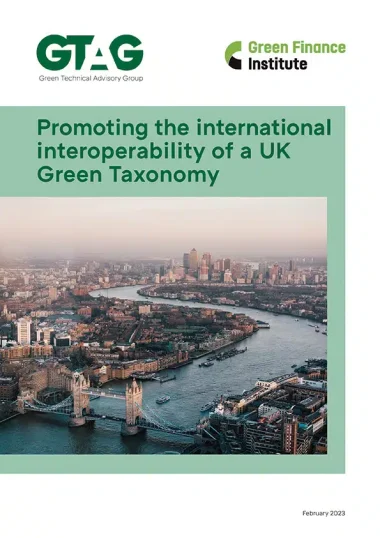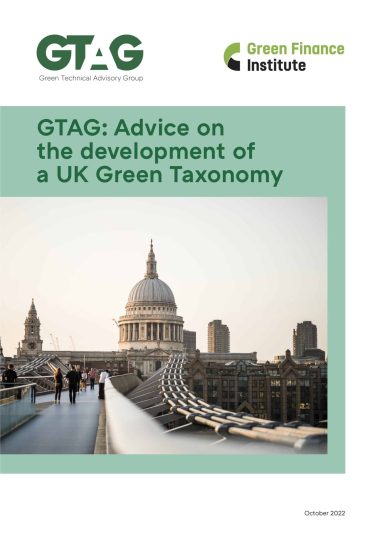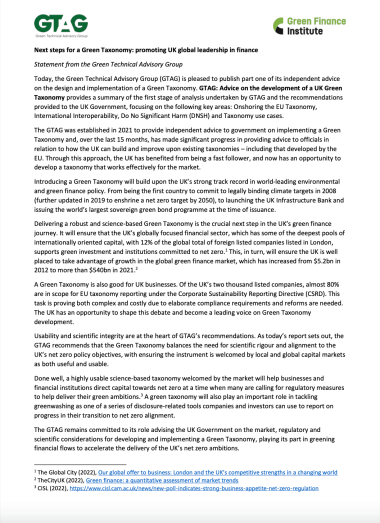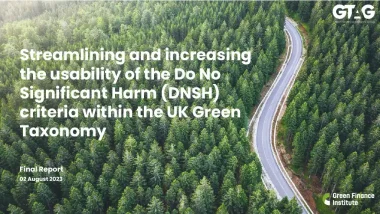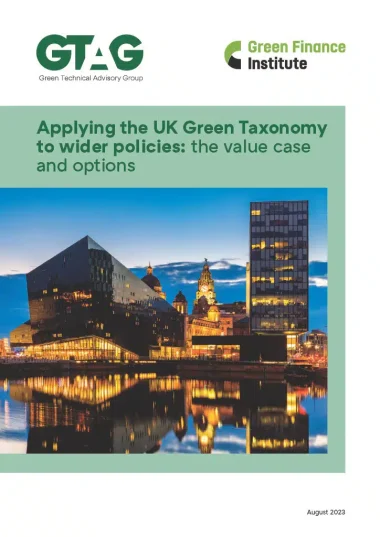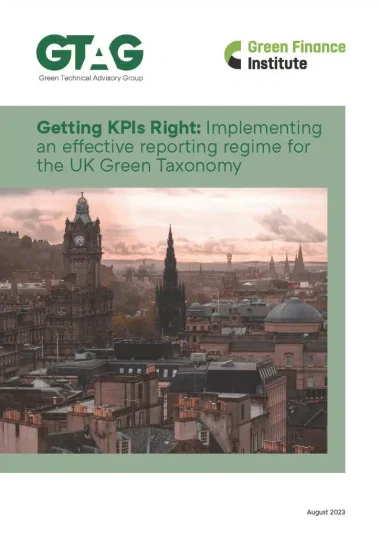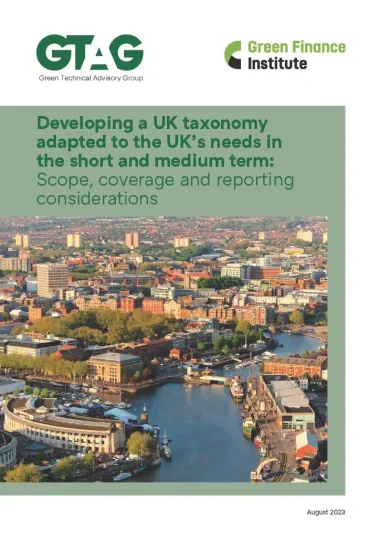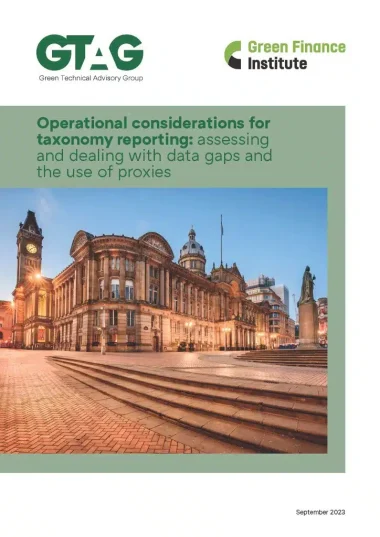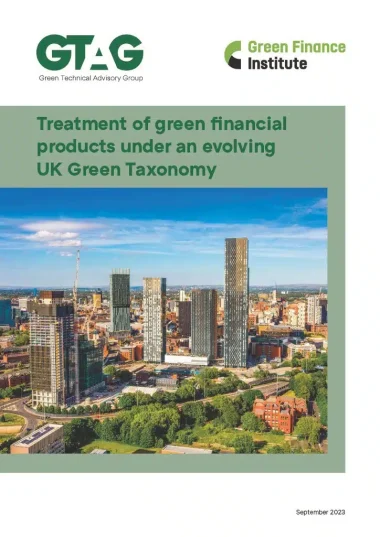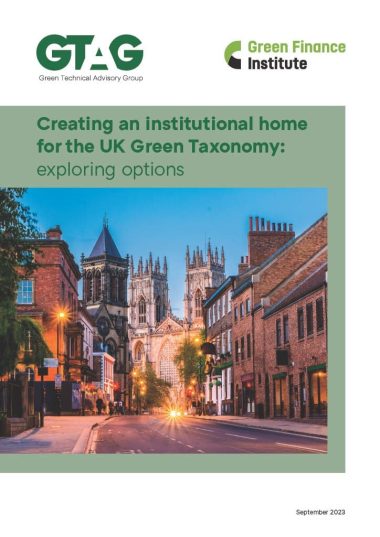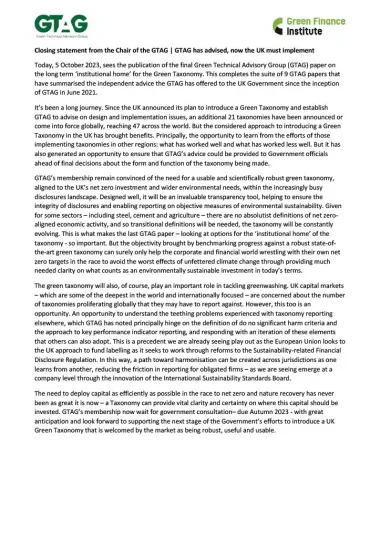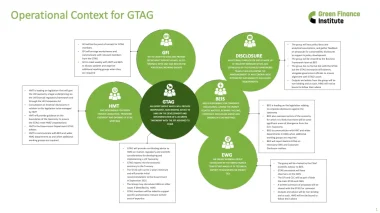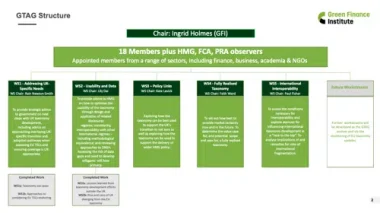UK Green Taxonomy

The Green Finance Institute provided the Secretariat for the Green Technical Advisory Group (GTAG) and currently provides the Secretariat for the Land, Nature and Adapted Systems (LNAS) Advisory Group. Both groups have provided independent, non-binding advice to Government on the design and implementation of a UK Green Taxonomy.
About the GTAG
The Green Technical Advisory Group (GTAG) is an expert group, chaired by the GFI, made up of key financial market stakeholders and subject matter experts. Its advice is considered as an input to the UK Government’s taxonomy development process. The role of the GTAG was to provide non-binding advice to HM Government (HMG) on market, regulatory and scientific considerations for developing and implementing a UK Green Taxonomy which facilitates more informed investment decisions. This included advising on:
- Approach to developing a UK Green Taxonomy that is usable and practicable for financial and non-financial firms.
- UK Green Taxonomy requirements which drive informed decision-making for investors while placing a proportionate burden on business.
- Drawing together scientific and subject matter expertise to assist the UK Government in determining technical screening criteria (TSC).
- The rationale, implications and recommendations for any deviations from existing international frameworks or taxonomies.
- How to manage any data gaps.
- How the UK Green Taxonomy can best support the UK’s transition to Net Zero and tracking green financial flows.
- How the taxonomy could be used to align and accelerate the delivery of wider policy.

The GTAG’s role was advisory. It was to feed into but not replace the Government’s policy development process, and the TSC will be subject to appropriate, open consultation prior to making. Further details about the role of GTAG can be found in the Terms of Reference.
About the LNAS
Following a recommendation from the Green Technical Advisory Group (GTAG), the Land, Nature, and Adapted Systems (LNAS) Advisory Group was announced and launched in the Green Finance Strategy in April 2023. LNAS is an expert group advising the Department of Environment, Food and Rural Affairs (Defra) on definitions of sustainable economic activities. The group’s work expands that of the GTAG, and its advice is considered as an input to the UK Government’s development of taxonomy criteria. These criteria will help accelerate investment into sustainable agriculture, fisheries and aquaculture, and into UK resilience to deliver climate and nature goals. The group is backed and funded by Defra and provides independent advice.
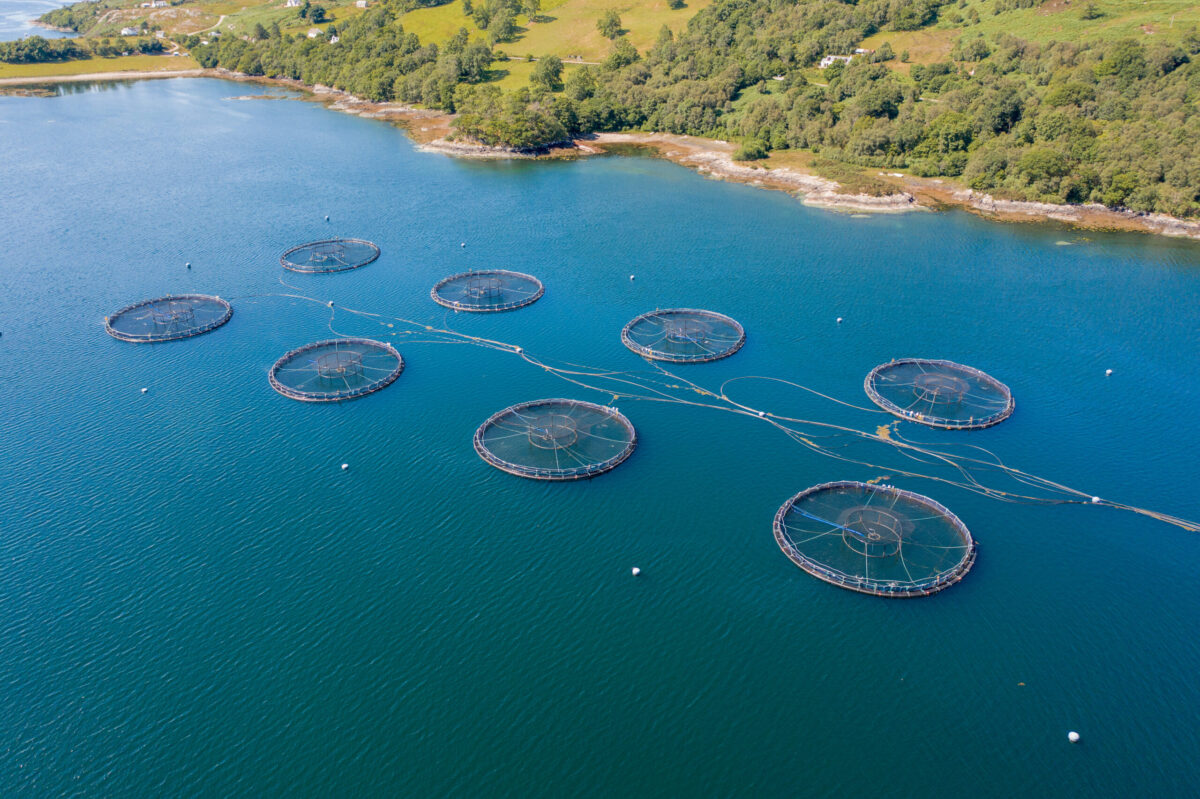
Overview / FAQs
1. What is the UK Taxonomy?
In November 2020, then Chancellor Rishi Sunak set out the UK Government’s ambition for the future of UK financial services, following the UK’s departure from the EU. Measures to support this aim included issuing the UK’s first ever Sovereign Green Bonds, becoming the first country in the world to make Task Force on Climate-Related Financial Disclosures (TCFD) disclosures mandatory and the implementation of a Green Taxonomy alongside the establishment of the UK Green Technical Advisory Group (GTAG) to review these metrics and ensure they are right for the UK market.
The UK Green Taxonomy is a common framework to set clear definitions of the economic activities and investments that can be defined as environmentally sustainable and thus help channel relevant UK-regulated firms’ capital towards net zero-aligned and nature positive investment, as well as addressing greenwashing.
It is anticipated that the consultation will be launched in early 2024.
2. What will it do?
The UK Green Taxonomy sets out detailed technical specifications of economic activities that can be defined as environmentally sustainable in the UK market. Starting with climate change mitigation and adaptation activities but expected to expand over time, its goal is to create clarity and consistency over what constitutes environmentally sustainable investment for UK-regulated firms.
3. What is it for?
The UK Taxonomy aims to direct investments towards green activities, encouraging businesses to adopt greener business models to increase taxonomy alignment over time. Additionally, the taxonomy will enhance transparency and comparability in sustainability practices among companies, credit institutions, and investors, helping address the issue of greenwashing and emergent reports of greenhushing.
4. How can businesses align with the requirements of the UK Taxonomy?
The UK Taxonomy is expected to define an economic activity as environmentally sustainable when:
1. The economic activity contributes significantly to one or more of the six environmental objectives.
2. The activity does not harm the other environmental objectives.
3. The activity is carried out in compliance with minimum safeguards.
In order to calculate the required KPIs (turnover, capital expenditure, operating expenditure), it is first necessary to determine the Taxonomy-eligible economic activities of the company. Subsequently, it must be examined whether these activities also fulfil the technical screening criteria for Taxonomy-aligned activities. As a result, the Taxonomy-aligned activities are identified, which are included in the calculation of the KPIs, i.e. the proportion of turnover, capital expenditure and operating expenditure associated with environmentally sustainable economic activities.
EU Taxonomy Example: Electricity generation from geothermal energy
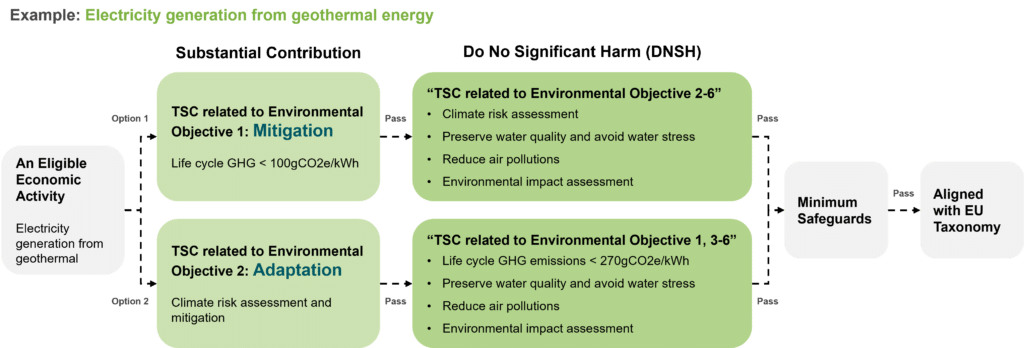
The UK Government will set out the UK’s approach in the upcoming consultation.
Publications
Promoting the international interoperability of a UK Green Taxonomy
Advice on the development of a UK Green Taxonomy
Statement on the publication of advice paper
Streamlining and increasing the usability of the DNSH criteria within the UK Green Taxonomy
Applying the UK Green Taxonomy to wider policies: the value case and options
Getting KPIs Right: Implementing an effective reporting regime for the UK Green Taxonomy
Developing a UK taxonomy adapted to the UK’s needs in the short and medium term: Scope, coverage and reporting considerations
Operational considerations for taxonomy reporting: assessing and dealing with data gaps and the use of proxies
Treatment of green financial products under an evolving UK Green Taxonomy
Creating an institutional home for the UK Green Taxonomy: exploring options
GTAG Final Statement
Summary of Advice
1. Advice on the development of a UK Green Taxonomy
Executive Summary
This paper provides a summary of the research and analysis undertaken by GTAG in its initial phase of work, including its rationale and the independent, non-binding advice it has provided to the UK Government on the market, regulatory and scientific considerations for developing and implementing a UK Green Taxonomy. Specifically, the paper summarises the first tranche of GTAG’s advice, focusing on four key themes: how to approach onshoring the EU framework; optimising the taxonomy’s international interoperability; streamlining Do No Significant Harm criteria to be usable and useful for reporting entities; and setting out wide range of potential taxonomy use cases.
Summarised Recommendations
1. Government should pursue an ‘adopt some and revise some’ approach to reviewing the EU TSC and should provide clear time-bound expectations for market actors about the development and finalisation of the UK Green Taxonomy, as well as pragmatic implementation guidance to mitigate some of the complexities of the EU TSC.
2. Follow principles for revising TSC to avoid greenwashing, maintain simplicity and usability, and ensure international relevance.
3. Simplify the ‘Do No Significant Harm’ criteria to make the taxonomy more user-friendly, while retaining its sustainability goals.
4. Align the UK Green Taxonomy with international standards to reduce market fragmentation and enhance global green finance flows.
5. Tailor criteria to UK-specific needs in various sectors, such as energy and buildings, to align with the UK’s net-zero targets and policy landscape.
6. Engage with market participants and stakeholders through consultations to refine the taxonomy and address implementation challenges.
7. Develop the taxonomy as a dynamic tool, subject to regular reviews and updates to reflect evolving scientific knowledge and market practices.
2. International Interoperability
Executive Summary
The GTAG report on the international interoperability of the UK Green Taxonomy emphasizes the need for global alignment in green finance. It underlines the importance of harmonising the UK’s sustainable investment framework with international standards to foster green investment and combat greenwashing.
GTAG’s 10 recommendations can be categorised under three broad headings: (1) interoperable Technical Screening Criteria (TSC), (2) interoperable disclosures, and (3) international engagement. These recommendations are intended to guide the UK in aligning its green taxonomy with global practices, ensuring robust and scientific criteria, and facilitating effective international collaboration in green finance.
Summarised Recommendations
1. Align concepts, methodologies, metrics, and thresholds with the EU Taxonomy where possible.
2. Ensure UK TSC are robust and science-based to demonstrate international leadership.
3. Conduct 3-yearly reviews to assess and adjust the UK Green Taxonomy in line with international developments.
4. Streamline language and requirements to maximise interoperability with non-EU jurisdictions.
5. Adopt taxonomy-related rules for subsidiaries and assets in various global jurisdictions.
6. Develop and publish a list of equivalent units for measurement practices in different jurisdictions.
7. Support the development of international base principles for reporting in non-OECD countries without a green taxonomy.
8. Provide guidance for voluntary reporting against the UK Green Taxonomy in the USA and non-taxonomy OECD countries.
9. Offer guidance on reporting international activities using KPIs under the UK reporting regime.
10. Advocate for harmonisation of taxonomies and international cooperation to develop a list of core economic activities equivalent to the UK Green Taxonomy.
3. Do No Significant Harm (DNSH)
Executive Summary
The report focuses on streamlining and enhancing the usability of the Do No Significant Harm (DNSH) criteria within the UK Green Taxonomy. It was written to address challenges in implementing DNSH criteria from the EU framework, aiming to make them more practical and usable for UK firms, while maintaining their scientific robustness.
Summarised Recommendations
1. HM Government should clarify the purpose, approach, and definition of DNSH in the UK Green Taxonomy.
2. Propose reporting additional information for activities not fully aligned with DNSH criteria.
3. HM Treasury should set parameters for drafting DNSH criteria to enhance consistency and usability.
4. Revise EU DNSH criteria for the UK context to improve usability without compromising scientific integrity.
5. Create comprehensive guidance to support effective implementation of the UK Green Taxonomy.
6. Advocate internationally for this revised approach to DNSH to lead in Green Taxonomy harmonisation.
4. Policy Links
Executive Summary
The report focuses on expanding the application of the UK Green Taxonomy beyond its initial scope, aiming to guide both public and private investments towards sustainable economic activities. It recognises the taxonomy potential in steering capital towards environmentally sustainable investments and combating greenwashing. The report was written to propose how the UK Green Taxonomy could be integrated into broader fiscal and policy decisions, enhancing investors’ confidence and establishing a clear, unified definition of ‘green’ investments.
Summarised Recommendations
1. UK Infrastructure Bank (UKIB) and British Business Bank (BBB): Use the taxonomy as a screening tool for sustainability and impact of investments.
2. Green Gilts: Align use of proceeds with the taxonomy.
3. Corporate Disclosures: Require disclosures of taxonomy alignment through Sustainable Disclosure Requirements (SDR).
4. Transition Plans: Include taxonomy alignment in transition plans framework.
5. FCA Labels and Disclosure Regime: Integrate taxonomy alignment as a key metric.
6. Net-Zero Test: Ensure public investments align with net-zero targets using the taxonomy as a Budget Tagging Tool.
7. Local Authority Finance: Advise local authorities on using the taxonomy for borrowing and spending; Public Works Loan Board (PWLB) to report lending alignment with the taxonomy.
8. National Infrastructure Commission (NIC) and Infrastructure Projects Authority (IPA): Use the taxonomy to embed net-zero and resilience in advice on infrastructure priorities.
9. Planning and Green Bond Standards: Incentivise taxonomy-aligned activities in planning; develop a Green Bond Standard aligned with the taxonomy.
10. Tracking Green Financial Flows: Use taxonomy for defining ‘green’ in tracking financial flows.
11. Public Procurement and Big Nature Impact Fund: Incentivise taxonomy alignment in procurement and investments.
12. High-Quality Carbon Offsets: Align activities with taxonomy criteria for carbon offset accreditation.
5. KPI Reporting
Executive Summary
The reporting focuses on the implementation of an effective reporting regime for the UK Green Taxonomy. GTAG’s recommendations are primarily focused on the key performance indicators (KPIs) that should be used in taxonomy reporting. Recommendations are aimed at streamlining the reporting process, improving transparency, and ensuring the effectiveness of green investments in aligning with sustainable goals.
Summarised Recommendations
Non-Financial Company Recommendations:
1. Maintain EU Taxonomy Regulation’s Article 8 requirements for firms to report on turnover and capital expenditure (capex) as primary green performance indicators.
2. Suggest operational expenditure (opex) reporting to be optional.
3. Call for clear and consistent definitions for turnover, capex, and opex KPIs.
4. Expand the scope of capex category C as set out in the EU’s Disclosures Delegated Act to encompass additional environmental objectives.
Credit Institution Recommendations:
1. Reassess the approach to the Green Asset Ratio (GAR).
2. Consider two approaches: exclude non-relevant activities/investments from GAR or limit GAR calculation to the bank’s lending book.
3. Propose setting up a working group to design TSC for financial services.
Investor Recommendations:
1. Recommend fund-level reporting and disclosing taxonomy components for each fund instead of using the Green Investment Ratio (GIR) at the entity level.
2. Apply fund-level reporting to all funds, irrespective of ESG labelling.
3. Differentiate between insurers’ proprietary investments and their unit-linked or with-profit businesses.
4. Explore TSC for financial services related to insurance premium discounts and adaptation measures.
6. Scope, coverage and reporting considerations
Executive Summary
The report explores the adaptation of the UK Green Taxonomy, focusing on its expansion, to better address the UK’s economic needs, drawing on EU and other jurisdictions’ experiences.
Summarised Recommendations
1. Prioritise the development of a credible, robust, usable green taxonomy before considering the expansion to cover other activities.
2. Focus on policy cohesion and develop transition plan guidance and sector-specific roadmaps.
3. Utilise existing taxonomy design features that factor in transition.
4. Consider the expansion of taxonomy coverage to sectors like wholesale and retail trade, manufacturing, agriculture, and potentially financial and advisory services.
5. Apply taxonomy reporting to companies subject to mandatory TCFD reporting.
6. Consult on limiting mandatory reporting to turnover and capex, with optional opex reporting.
7. Assess the international landscape of extended taxonomies for best practices and potential implementation challenges.
8. Promote the UK’s transition rationale and approach internationally.
7. Data gaps and proxies
Executive Summary
The report focuses on operational considerations for taxonomy reporting, specifically addressing data gaps and the use of proxies in the UK Green Taxonomy. The advice paper provides recommendations on minimising data gaps and ensuring robust, decision-useful taxonomy disclosures without overburdening businesses. It also covers the use of proxies and estimates in taxonomy reporting.
Summarised Recommendations
1. Learn from other taxonomies and sequence mandatory disclosures to ensure sufficient information availability.
2. Implement GTAG’s recommendations to enhance the usability of the UK Green Taxonomy.
3. Provide comprehensive guidance for voluntary disclosure of taxonomy alignment, including start-to-finish examples of assessment against the taxonomy.
4. Create a forum for stakeholders to raise data issues, challenges, and questions during the voluntary period.
5. Be mindful of global companies’ data requirements, considering international applicability.
6. Support the use of estimates during the voluntary reporting period, providing clear instructions for their use in disclosures.
7. Develop a reporting template for consistent disclosures during the voluntary period.
8. Treatment of green financial products
Executive Summary
The report aims to provide clarity on how existing and future green financial products should be treated as the taxonomy criteria evolve. This is crucial for maintaining market confidence and minimising risks of greenwashing. GTAG suggests a balanced approach, emphasizing the need for clear and consistent regulations and guidance.
Summarised Recommendations
1. HM Government (HMG) should clarify the treatment of existing and future green products in relation to the evolving taxonomy.
2. Implement a ‘grandfathering’ clause for green debt issuers, allowing most green bonds and loans to remain aligned until maturity, even if criteria change.
3. For equity, establish a set time period for taxonomy alignment, considering exceptions for long-term infrastructure projects.
4. Assess refinanced green debt against the latest taxonomy criteria, overriding existing grandfathering periods.
5. The Government and Financial Conduct Authority (FCA) should align their approaches to green and sustainability bonds.
6. Additional guidance, including methodology and case studies, should be published to assess complex green investments against the UK Green Taxonomy.
9. Institutional Home
Executive Summary
The report explores the establishment of an institutional home for the UK Green Taxonomy. It emphasizes the need for enduring governance and a robust framework to guide the taxonomy’s development and implementation, ensuring it remains effective and relevant. The paper outlines various options for the institutional structure, assessing their suitability based on the UK’s commitment to implementing a Green Taxonomy and the need for transparency, integrity, and adaptability in its governance.
Summarised Recommendations
1. Establish an Advisory Body to guide the initial implementation and development of the taxonomy.
2. Utilise Executive action to allocate necessary funding and resourcing for this body.
3. In the medium-term, initiate legislation for a long-term statutory decision-making body.
4. Consider the Financial Reporting Council/Audit Reporting and Governance Authority (FRC/ARGA) as a potential candidate for this role, subject to funding and resource availability.
5. Consult with relevant bodies, like the Climate Change Committee, to ensure scientific rigor in the taxonomy’s development.
6. Draft new legislation or amend existing laws to empower the chosen body with necessary authority and funding.
Members
The GTAG consisted of 18 original members, 4 ad-hoc members, plus a chair, made up of financial and business stakeholders, taxonomy and data experts, and subject matter experts drawn from academia, NGOs, the Environment Agency and the Committee on Climate Change.

Users of the taxonomy
Financial Services
Users of the taxonomy
Non-Financial Services
Users of the taxonomy
Taxonomy & Data Experts
Users of the taxonomy
Academia & Subject Matter Experts
International Taxonomy Dashboard
The GTAG advice paper “Promoting the International Interoperability of a UK Green Taxonomy” outlines ten recommendations for working towards international interoperability without compromising the robustness or science-based nature of a UK Green Taxonomy.
Discussions on interoperability are increasingly necessary given that taxonomies and definitions of sustainable activities have proliferated rapidly. Currently, over 50 taxonomies around the world are in development or being implemented. This continued provision of national taxonomies, however, could exacerbate problems associated with market fragmentation, increase transaction costs as well as the risks of greenwashing through taxonomy arbitrage that may undermine efforts to promote cross-border green capital flows.
Improved coordination, therefore, is needed to facilitate the comparability and consistency of different alignment approaches. The GFI have developed an interactive dashboard tool to help with the navigation of these taxonomies – the international taxonomy tracker.
View our International Taxonomy Dashboard below:
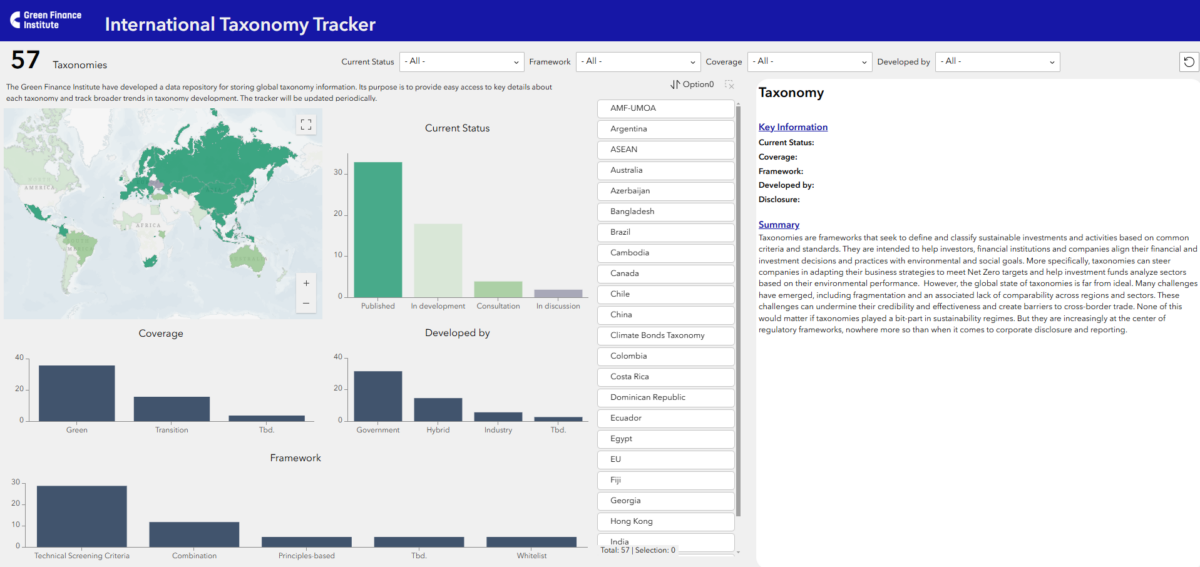
Launched as a beta version, the international taxonomy dashboard will be refined and updated periodically.
Contact us
For more information please contact






